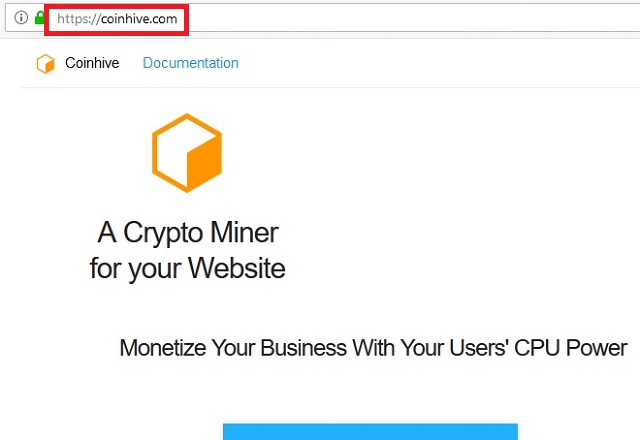Please, have in mind that SpyHunter offers a free 7-day Trial version with full functionality. Credit card is required, no charge upfront.
This article can help you to remove Coin-hive.com Virus. The step by step removal works for every version of Microsoft Windows.
You’ve noticed a sudden change in your computer performance? Perhaps your applications are running slower than usual and while playing, your games are stuttering or freezing? The probable cause of this is alarming – the installation of Coinhive Miner on your computer. The Coinhive Miner in its nature is a JavaScript library developed by webmasters for mining cryptocurrency. The website Coin-hive.com contains this particular software. What this library does is that it uses the website visitor’s processing power to mine the cryptocurrency. The bad news is, the website visitors will be oblivious to the fact that their processor is being used without their knowledge and consent.

How did I get infected with?
The Coinhive malware can get into your computer as an additional program from a recent installation you did. Which is why it is very important to be careful when you install programs on your computer. Pay close attention to what additional software comes with it! More often than not, it is malware in disguise! Another way to get your PC infected by it is by a browser extension. This way, the Coinhive miner works by injecting an in-browser miner from coin-hive.com/lib/coinhive.min.js which results in the successful use of more than 50% of your CPU’s power, as well as graphics card power.
Why is this dangerous?
The cryptomining malware is continuing to grow rapidly. Cybercriminals are attracted to it because the users are unlikely to find out about this malicious software. Normally the victim would think that there is another reason behind the general slowness when using the computer or web browsers. Which is why users must pay close attention when they notice that their programs run slower than usual or if windows maximize and minimize slowly. If you have any suspicion that your computer might be infected, you need to proceed timely. Don’t risk your computer’s safety – run routine scans and check your browser extensions for any potential threats.
Manual Coin-hive.com Removal Instructions
The Coin-hive.com infection is specifically designed to make money to its creators one way or another. The specialists from various antivirus companies like Bitdefender, Kaspersky, Norton, Avast, ESET, etc. advise that there is no harmless virus.
If you perform exactly the steps below you should be able to remove the Coin-hive.com infection. Please, follow the procedures in the exact order. Please, consider to print this guide or have another computer at your disposal. You will NOT need any USB sticks or CDs.
Please, have in mind that SpyHunter offers a free 7-day Trial version with full functionality. Credit card is required, no charge upfront.
STEP 1: Track down Coin-hive.com related processes in the computer memory
STEP 2: Locate Coin-hive.com startup location
STEP 3: Delete Coin-hive.com traces from Chrome, Firefox and Internet Explorer
STEP 4: Undo the damage done by the virus
STEP 1: Track down Coin-hive.com related processes in the computer memory
- Open your Task Manager by pressing CTRL+SHIFT+ESC keys simultaneously
- Carefully review all processes and stop the suspicious ones.

- Write down the file location for later reference.
Step 2: Locate Coin-hive.com startup location
Reveal Hidden Files
- Open any folder
- Click on “Organize” button
- Choose “Folder and Search Options”
- Select the “View” tab
- Select “Show hidden files and folders” option
- Uncheck “Hide protected operating system files”
- Click “Apply” and “OK” button
Clean Coin-hive.com virus from the windows registry
- Once the operating system loads press simultaneously the Windows Logo Button and the R key.
- A dialog box should open. Type “Regedit”
- WARNING! be very careful when editing the Microsoft Windows Registry as this may render the system broken.
Depending on your OS (x86 or x64) navigate to:
[HKEY_CURRENT_USER\Software\Microsoft\Windows\CurrentVersion\Run] or
[HKEY_LOCAL_MACHINE\SOFTWARE\Microsoft\Windows\CurrentVersion\Run] or
[HKEY_LOCAL_MACHINE\SOFTWARE\Wow6432Node\Microsoft\Windows\CurrentVersion\Run]
- and delete the display Name: [RANDOM]

- Then open your explorer and navigate to: %appdata% folder and delete the malicious executable.
Clean your HOSTS file to avoid unwanted browser redirection
Navigate to %windir%/system32/Drivers/etc/host
If you are hacked, there will be foreign IPs addresses connected to you at the bottom. Take a look below:

Step 4: Undo the possible damage done by Coin-hive.com
This particular Virus may alter your DNS settings.
Attention! this can break your internet connection. Before you change your DNS settings to use Google Public DNS for Coin-hive.com, be sure to write down the current server addresses on a piece of paper.
To fix the damage done by the virus you need to do the following.
- Click the Windows Start button to open the Start Menu, type control panel in the search box and select Control Panel in the results displayed above.
- go to Network and Internet
- then Network and Sharing Center
- then Change Adapter Settings
- Right-click on your active internet connection and click properties. Under the Networking tab, find Internet Protocol Version 4 (TCP/IPv4). Left click on it and then click on properties. Both options should be automatic! By default it should be set to “Obtain an IP address automatically” and the second one to “Obtain DNS server address automatically!” If they are not just change them, however if you are part of a domain network you should contact your Domain Administrator to set these settings, otherwise the internet connection will break!!!
- Check your scheduled tasks to make sure the virus will not download itself again.
How to Permanently Remove Coin-hive.com Virus (automatic) Removal Guide
Please, have in mind that once you are infected with a single virus, it compromises your whole system or network and let all doors wide open for many other infections. To make sure manual removal is successful, we recommend to use a free scanner of any professional antimalware program to identify possible virus leftovers or temporary files.




